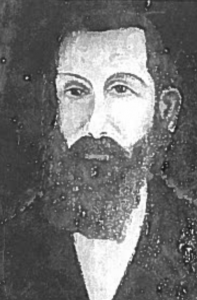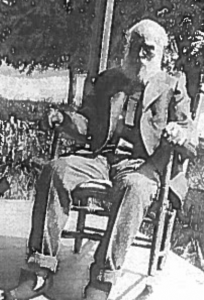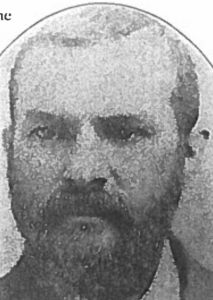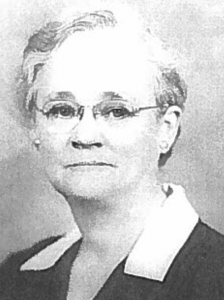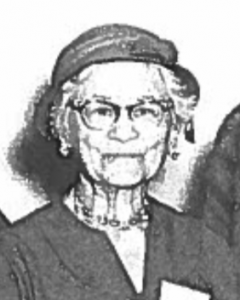- Robert Harris
- Andrew “Jack” Chesnutt
- Cicero Harris
- Anne Chesnutt
- Sarah Chesnutt
Photo credit: Fred Whitted, Black America Series: Fayetteville North Carolina. Charleston, South Carolina. Arcadia Publishing. 2000
Education and Opportunity in Northwest Ohio
For the most part, free mulattoes migrated toward the Northwest Territory. The 1850 census lists 57,000 free mulattoes outside the South. Of this group, 43,000 lived in New York, Pennsylvania, Indiana and Ohio, with remainder scattered in states from Maine to California. Of that number, 30,000 lived in Pennsylvania and Ohio. According to the census, 244 people of color lived in Cleveland, where the opportunity for education, as well as escape from terrorism, influenced immigration to Northeast Ohio. The history of education for free people of color in Northeast Ohio begins in 1802 with the Ohio Constitutional Convention, which passed two items of significance here– the Ohio Black Laws and education at public expense.
The delegates from Northeast Ohio to the 1802 Ohio Constitutional Convention rejected slavery by only one vote, leaving little doubt regarding general attitudes toward people or color. With their support, the state constitution came to include seven provisions known as the Ohio Black Laws intended specifically for black and mulatto people. Like Black Laws in other states, the Ohio Black Laws were anti-immigration legislation intended to discourage fugitive slaves from settling in the state and confine those who did live in the state to their home communities. (See Lovett, Appendix.) Enacted between 1804 and 1807, the Ohio Black Laws read as follows:
Section 1. Be it enacted by the General Assembly of the State of Ohio, That from and after the first day of June next. no black or mulatto person shall be permitted to settle or reside in this state, unless he or she shall first produce a fair certificate from some court within the United States, of his or her actual freedom, which certificate shall be attested by the clerk of said court, and the seal thereof annexed thereto, by said clerk.
Sec. 2. And be it further enacted , That every black or mulatto person residing within this state, on or before the fifth day of June, one thousand eight hundred and four, shall enter his or her name, together with the name or names of his or her children, in the clerk’s office in the county in which he, she or they reside, which shall be entered on record by said clerk, and thereafter the clerk’s certificate of such
record shall be sufficient evidence of his, her or their freedom; and for every entry and certificate, the person obtaining the same shall pay to the clerk twelve and an half cents. Provided nevertheless, That nothing in this act contained shall bar the lawful claim to any black or mulatto person.
Sec. 3. And be it further enacted , That no person or persons residents of this state, shall be permitted to hire, or in any way employ any black or mulatto person, unless such black or mulatto person shall have one of the certificates as aforesaid, under pain of forfeiting and paying any sum not less than ten nor more than fifty dollars, at the discretion of the court, for every such offense, one-half thereof for the use of the informer and the other half for the use of the state; and shall moreover pay to the owner, if any there be, of such black or mulatto person, the sum of fifty cents for every day he, she or they shall in any wise employ, harbour or secret such black or mulatto person, which sum or sums shall be recoverable before any court having cognizance thereof.
Sec. 4. And be it further enacted , That if any person or persons shall harbour or secret any black or mulatto person, the property of any person whatever, or shall in any wise hinder or prevent the lawful owner or owners from retaking and possessing his or her black or mulatto servant or servants, shall, upon conviction thereof, by indictment or information, be fined in any sum not less than ten nor
more than fifty dollars, at the discretion of the court, one-half thereof for the use of the informer and the other half for the use of the state.
Sec. 5. And be it further enacted, That every black or mulatto person who shall come to reside in this state with such certificate as is required in the first section of this act, shall, within two years, have the same recorded in the clerk’s office, in the county in which he or she means to reside, for which he or she shall pay to the clerk twelve and an half cents, and the clerk shall give him or her a certificate of
such record.
Sec. 6. And be it further enacted , That in case any person or persons, his or their agent or agents, claiming any black or mulatto person that now are or hereafter may be in this state, may apply, upon making satisfactory proof that such black or mulatto person or persons is the property of him or her who applies, to any associate judge or justice of the peace within this state, the associate judge or justice is hereby empowered and required, by his precept, to direct the sheriff or constable to arrest such black or mulatto person or persons and deliver the same in the county or township where such officers shall reside, to the claimant or claimants or his or their agent or agents, for which service the sheriff or constable shall receive such compensation as they are entitled to receive in other cases for similar services.
Sec. 7. And be it further enacted , That any person or persons who shall attempt to remove, or shall remove from this state, or who shall aid and assist in removing, contrary to the provisions of this act, any black or mulatto person or persons, without first proving as hereinbefore directed, that he, she or they, is or are legally entitled so to do, shall, on conviction thereof before any court having cognizance of the same, forfeit and pay the sum of one thousand dollars, one-half to the use of the informer and the other half to the use of the state, to be recovered by action of debt, qui tam , or indictment, and shall moreover be liable to the action of the party
injured.
Along with the Black Laws, the 1802 Ohio Constitution Convention also passed an ordinance that required every township included under the ordinance to allocate property to be protected from sale and maintained for public schools. Education at public expense was more an inducement for (white) migration and land purchase than the desire to foster education. The Ohio Company and the Board of Treasury guaranteed potential settlers that one section in each township purchase would be reserved for common schools and the ordinance was included in the contract. Most important, laws regarding provisions for education were to be left to the discretion of the local township.
In 1821, the Trustees of the village of Cleveland raised over $200 for the construction of the Cleveland Academy, a new two-story brick schoolhouse to be located on the north side of St. Clair Avenue. The school opened on June 26, 1822 under the direction of Rev. William McLean and Harvey Rice, who served as instructor and principal until 1826. Students ranged in ages from 8 to 21 and were charged $4 tuition for each twelve- week term, with curriculum consisting of reading, spelling, writing, geography, Greek, Latin, and mathematics. The Academy operated as a private primary school until 1830, when competition from other private institutions in Cleveland led to its sale by the trustees. By 1842, there were 15 public schools enrolling 1,200 students. In 1844, the school manager, Charles Bradburn established Central High School, the first public high school providing free secondary education at public expense. The school opened on July 13, 1846, and its curriculum included English, mathematics, natural science, rhetoric, philosophy and bookkeeping. On May 5, 1847, Bradburn, recommended to the city council that the Academy be demolished and the lot used for new schools. The building was torn down in the winter of 1849 and the West St. Clair School built for the cost of $6,000.
When the public-school system took hold in Ohio, citizens and legislators alike objected to educating blacks from public funds in part because it would tend to encourage other blacks to come there and settle. But in the end, Ohio, like Pennsylvania, required its district school directors to set up separate facilities for black and white children. Still, segregation was not enough for many Ohio whites, who insulted, opposed, and sometimes literally attacked private schools set up to teach black children. In 1837, a newly opened school for blacks was destroyed in Zanesville, and another destroyed in Troy in 1840.
Before 1848, black property owners were not taxed for educational purposes: to have done so would mean that black children could attend (white) public schools. As a result, activist John Malvin convened a committee of black citizens also concerned about the lack of educational opportunities for the city’s black children. Together, these men succeeded in instituting a subscription system of monthly payments from black citizens of the city. The Cleveland Free School, or Colored Free School, was organized in 1832 and students included adults, whose education had been banned in southern states, as well as children. The Free School operated on a system of monthly payments from black citizens until 1848, when a law was passed providing for tax-supported black schools.
In 1849 the Free Soil Party negotiated a rare compromise that ended bond-posting requirements established in the Ohio Black Laws, as well as the prohibition of blacks and mulattoes from testifying in legal cases involving whites. After 1850, Cleveland Public Schools were fully integrated, with more anti-black laws were excluded from the 1851 Ohio Constitution, granting African Americans access to most churches and public institutions. By the end of the Civil War, Cleveland’s African American population had an overall standard of living higher than most black communities in the urban north. For example, in 1850, only eighteen people of color owned property in the Cleveland community. By 1870, that number had risen to 101. Moreover, property owners included unskilled laborers and domestic servants who, because of Cleveland’s relatively unusual educational and economic opportunities, were able to accumulate modest holdings. This would explain how Chloe Sampson, after arriving in Cleveland with Anne Marie in 1856, was able to use her life savings to purchase a house on Hudson Street in the 6th Ward. Her home was in an old German area in a community known for its thriving gardens, and her neighbors were both black and white.
Creating Education and Opportunity in Fayetteville, North Carolina
Ironically, just as education was a factor for free people of color leaving Fayetteville, it was also a factor in their return.
Also traveling in the caravan from Fayetteville was Andrew “Jack” Chesnutt, who was heading for Indiana to live and work with an uncle, but returned to Cleveland the following July to marry Anne. Jack found work as a driver-conductor on the Woodland Avenue Street Railroad, one of the first of the city’s horse-drawn lines to use rails. The couple lived with Chloe on Hudson Street, where their first child, Charles, was born in June, 1858. Soon after Jack moved his family to Oberlin where he worked for the next two years as an assistant wheelwright, building and repairing wheels. Like other African Americans in Northeast Ohio, Jack was an active participant in the abolitionist movement and it was during this time that he took part in the Oberlin-Wellington Rescue, a highly-publicized incident that intensified public sentiment regarding the constitutionality of the Fugitive Slave Act. After the birth of their second son, Lewis, the family returned to Cleveland, where Jack was re-hired as a driver-conductor. Two more children were born: another son, Russell, and a daughter, who died shortly after birth. By then the Civil War had begun and Jack left Cleveland to work as a teamster for the Union Army. With Jack away, Anne and her sons stayed with Chloe, where Charles would have attended the integrated Hudson Street School.
Although there is no record of Andrew Chesnutt serving as a teamster, given his work history, the probability seems credible. An article in Harper’s Weekly, dated March, 1863, describes the importance of African American teamsters in the Civil War:
In the Army of the Potomac there are probably from 8,000 to 10,000 negroes employed as teamsters. This is a business they are well fitted for, and of course it relieves an equal number of white men for other duties. A teamster's life is a very hard one, particularly at this season of the year. It does not matter how much it storms, or how deep the mud, subsistence must be hauled to the camps, and day and night, toiling along with tired horses and mules, the creaking wagons are kept busy carrying to and fro commissary, quarter-master, and ordnance stores, in addition to keeping the camps supplied with fire-wood. White teamsters have $25 a month. Colored men are paid $20, an increase of $10 a month on 'Contrabands pay' previous to the proclamation of emancipation.
It was Jack Chesnutt’s work as a teamster that led the family back to North Carolina. While in the area, he learned that his father was ill and returned to Fayetteville, where his father helped him to purchase a small store. Jack sent for his family and, much to her chagrin, Anne Marie left Cleveland, returning to Fayetteville by train with her three young sons. Once the family resettled, the store enabled a means of income, even if scanty. But there was still the question of education. In 1866, Congress expanded the power of the Freedman’s Bureau, established in 1865, to provide medical care, lease land, and establish schools. Given the history of repercussions for teaching slaves, official numbers projecting illiteracy were disproportionately high. However, because of people like Anne Marie, interviews with slaves revealed there was far less illiteracy than was reported. Moreover, figures for illiteracy recorded only slaves, excluding free people of color. As a result, final estimates held that at least four hundred thousand people, roughly ten-percent of the African American population, had been taught the fundamentals of literacy.
Nevertheless, education was more than teaching the fundamentals of reading and writing and, for as brave as they were, that first generation of teachers lacked classroom experience.
By 1860, teaching was a profession in America, and one that required formal training. Teachers needed to know how to divide classes according to age and ability, how to organize lessons, how to manage students without the threat of corporal punishment, how to grade student performance and how to determine student progress. At the same time, teaching was still a young profession and while professional training was available through normal schools, in 1861, there were only twenty normal schools in the country, eighteen of which were in the North. Not surprisingly, by 1866, of the 1300 teachers sponsored by freedman aid groups and Northern churches, ninety percent of those teachers were white.
The effort to educate children of color faced several hurdles. Although willing to teach in the South, white teachers from the North were resented (if not hated) by white southerners. These teachers were constantly under threat and keeping them safe became a major concern for the Bureau. Although there were southern white teachers, most accepted the position only because other jobs were so scarce. As a result, few were sympathetic to the advancement of newly emancipated slaves. Lack of schools was another problem, with most classes held in churches, basements, and even abandoned buildings. But it was never the intention of the African American community that white teachers be the sole source of educators and community leaders continued to request African American teachers.
The black community in Fayetteville began plans for educating school-age youth immediately after the war. Consequently, by the time Jack Chesnutt returned to Fayetteville in 1866, the community had opened two schools, one for primary and one for intermediate. By then, however, both schools were struggling. Unknown to Jack or Anne, Robert Harris had also returned to Fayetteville after years of living in Cleveland. Nor did he realize that he, along with other black citizens, would form an alliance with Harris that would change the face of black education in the state of North Carolina.
The Harris family left Fayetteville for Ohio in 1850. The family first lived in Chillicothe, then moved to Cleveland, where the siblings, including their three sons William, Robert and Cicero, attended the Cleveland Public High School. After graduation, Robert and William were both trained as plasterers. Later, both applied to the American Missionary Association for certification as teachers and both received appointments to teach in Virginia in 1864. While William remained in Virginia, Robert returned to Fayetteville in 1866. It was Robert who suggested that the two schools consolidate. The first classes were held in the Evans AME Church, the city’s oldest church, founded by Henry Evans, a black ordained preacher in 1796. In 1867, seven men contributed $140 to purchase two lots for an official building: storekeeper Jack Chesnutt; David A. Bryant, a farmer; three ministers: Robert Simmons, Thomas Lomax, and George Grainger; and Matthew N. Leary, a businessman and whose brother, Lewis Sheridan Leary, also took part in the Oberlin-Wellington Rescue. The land was then donated to the Freedman’s Bureau, who contributed $4,200 to build and, with a petition to the Peabody Fund, furnish the school with free books and other supplies. This became the Howard School, named after General Oliver O. Howard, the first director of the Freedman’s Bureau.
The school opened in 1868 with Robert Harris as principal, and his younger brother, Cicero, as his assistant. Under Robert’s guidance, the Fayetteville Howard School became one of the top schools founded under the Freedman’s Bureau in North Carolina. Young Charles was able to attend the Howard School for four years. After school, he worked at his father’s store and helped Anne Marie, who gave birth to three more children before her death in 1871. While the community’s access to education was a priority to Jack Chesnutt, continued education for his sons was not. In 1872, when Charles was fourteen, Jack insisted his eldest son leave school and find employment. It was Robert Harris who convinced Jack to let Charles to remain in school and earn money as a pupil-teacher. When Charles was sixteen, Robert encouraged him to apply to the United States Naval Academy and worked with state officials gaining support for the application. Although Charles received high marks on the entrance exam, he was denied admission because of his race. Robert then arranged for Charles to move to Charlotte to assist his brother, Cicero Harris, who had become principal of a school in Charlotte similar to the Howard School. He spent his summers trying to find work in smaller school districts, usually with no success.
It was at this time that Chesnutt began his journal that would chronicle the next eight years of his life. The journals would record his frustration, his youth and his maturation but most of all, they would record a time of study, a tremendous learning process, and a fierce determination to acquire an education for advancement. As the journals reveal, Chesnutt spent most of this free time studying areas requisite for entrance to university. These self-taught studies included history, literature, French, German, and languages of classical Western civilization. He excelled in German, finally finding a tutor willing to work with a Negro. His favorite subject was Latin, which was also essential for access to a university education. But Chesnutt was never to attend a university or receive any formal education from an institute of higher learning. He soon replaced Cicero as the principal of a public school in Charlotte and in 1877, returned to Fayetteville. That year, the State of North Carolina established the Howard School as the new Normal School, approved to train teachers for the state’s colored schools. Robert Harris was appointed the first principal of the Normal School and Charles worked as Robert’s first assistant, as well as teaching various subjects, including reading, writing, and composition. At nineteen, Chesnutt drew an annual salary of $2,000 and it was at this time he met Susan Perry, another young teacher at the school, whom he married on June 6th in 1878. When Robert Harris became ill in March of 1880, it was Charles who took over his duties as principal following Robert’s death later in the year.
At twenty-one, Chesnutt was now a married man with two daughters. In an effort to provide financial security for his family, he began to study phonology and Pittman shorthand (stenography) in 1878 and, within eight months, was proficient enough to record sermons. As his skills progressed so did confidence in his ability, as he recalls in a later journal entry:
Before I was half through learning it, I had determined to seek employment when I had finished my studies in Phonography. I had before engaged myself to report a series of lectures for Professor Ladd this summer, if he secured the appointment as teacher of the white normal school, but I soon began to think that a small matter. I would seek a larger field; I would go North immediately and secure a position as official reporter for Congress or on the staff of some large newspaper. As I acquired greater skill I gave full rein to my exuberant fancy, and indulged my propensity for castle-building to a fearful extent. From the gains I made with my art, I sent Lewis and Andrew to College; gave up my position in the normal school; built a fine house, edited a great Journal, and acquired a world wide reputation. (Journals, 111)
True to his dream, in 1879, Chesnutt set out on a trip to Washington, D.C. to find employment as a stenographer. Unlike his dream, the trip was unsuccessful. However, the experience was particularly insightful, as revealed in a journal entry, dated April 1879:
Well I am home again, a poorer but wiser and happier man. This little experiment has taught me; first, that I did not understand Phonography sufficiently enough to become an official reporter; secondly, that If I had it was difficult to get a position, on account of the great competition. …. It is the fault of youth, and of myself in particular, to want to walk before having learned to crawl. (Journals, p. 119)
In the summer of 1883, his stenography skills having improved since the visit to Washington, Chesnutt once again left Fayetteville to find work in the North. This time he traveled to New York and this time the trip was successful.
Ezekiel Ezra Smith was hired to replace Charles Chesnutt and, with the exception of nine years of government appointments, served the school for fifty years. It was Smith who expanded the school and who made the final payment on fifty-acres for the new campus from his own funds in 1907. Moreover, while Chesnutt left Fayetteville, his departure did not end his family’s association with the school. Education remained a family legacy. His sister, Sara, a student at the Howard School, went on to attend the Fayetteville State Colored Normal School, then continued as a teacher for over thirty years. His sister, Anne, who also attended the Howard School, went on to teach in the Fayetteville school system for twelve years before becoming the supervisor for Cumberland County Schools, a position she held for twenty-two years. Following her retirement, one of the first all-black high schools was named in her honor.

